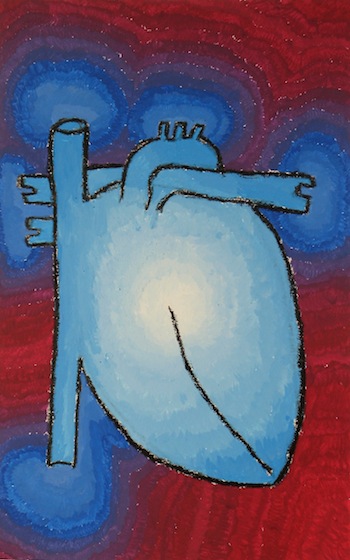“Question Mark” by Sydney Freedman and Rachel Pekeles is among the works created by King David High School Grade 12 students. (photo by Nancy Current)
In conjunction with their current show at Zack Gallery, Visual Midrash, artists Robin Atlas and Nancy Current conducted a two-day workshop with the Grade 12 students of King David High School. Rabbi Stephen Berger, head of the school’s Judaic studies, and some of his more outgoing students talked to the Independent about the project.
“Every year, we do a project for Passover with our Grade 12 students,” said Berger. “The Haggadah is one of those Jewish texts that’s had the most number of interpretations throughout our history, as every generation and every family bring their own understanding. So, I ask the students every year to write their own versions, a short essay on one of the aspects of the Haggadah. This year, we decided to combine the writing with the visual component. The students pitched their ideas, which topic they wanted to explore. I tried to limit the same topics but I didn’t force anyone. They were free to choose. Now, after all the art is done, we’ll put the project online. We’re also going to publish a hardcopy as a pamphlet. One of our former students, Daniel Wiseman, is helping me with the particulars. We will distribute the copies at the JCC, at the synagogues and Jewish delis.”
The rabbi joined his students in creating his own interpretation of the Haggadah, using a sheet of matzah as the base for his artistic journey. “Matzah represents both our slavery and our freedom,” he said. His piece opens the pamphlet.
Like the rabbi, most of his students hadn’t done much visual art in years and were not going to pursue art as a career, but they enjoyed working on Visual Midrash for this assignment.
“They put so much thought into their pieces,” said Current. “Some of them first tried to come up with concrete images, but it’s hard without artistic training. Then Robin and I suggested they should think about some abstract interpretations. What ideas come to mind? What concepts are associated with those ideas? The results were amazing.”
One of the students, Izzy Khalifa, chose the most fun-filled tradition of Passover – the search for bread. “When I was a kid, it was a game in our home. I loved it,” she said. “Now that I’m older, I think it’s not simply a search for bread but it has a deeper meaning, like a search for yourself.”
“Judaism grows on you,” the rabbi remarked, and Khalifa agreed. She also liked working with the abstract concept. “People can take more from an abstract picture, interpret it in different ways,” she said.

Classmates Adi Rosenkrantz and Ashley Morris decided on more concrete imagery. Their blue heart on a blood-red background symbolizes the first plague of Egypt – the plague of blood. “The blue heart is like the heart of the Nile,” said Rosenkrantz. “The abrupt color change, from blue to red, from water to blood, disrupted the Egyptian way of life.” Their heart is almost anatomically precise. “I just did a unit on cardiovascular system,” Rosenkrantz explained, “and it was fresh in my mind.”
Ma’ayan Fadida and Shmuel Hart’s illustration was more metaphorical. They selected a controversial theme for their work – the wicked son. In their artistic interpretation, the wicked son walks a black path, which winds its way across the pink and orange brightness of other family members.
“We wanted to do one of the sons,” Fadida said. “This one makes the decision to separate himself from the others; that’s why his path is black. And the abstract allowed us to show how he was thinking.”
One of the most powerful pieces is a mixed media collage: a large black question mark with the background of newspaper snippets. Created by Sydney Freedman and Rachel Pekeles, it also touches on the story of the four sons but focuses on the son who doesn’t know how to ask.
“We wanted to take a complicated topic and present it as a symbol. The black mark blocks our ability to ask,” explained Freedman.
“The information is all there. You just have to be willing to look for it,” Pekeles elaborated. “It is a challenge. Sometimes, we choose not to ask when we should.”
Olga Livshin is a Vancouver freelance writer. She can be reached at olgagodim@gmail.com.

